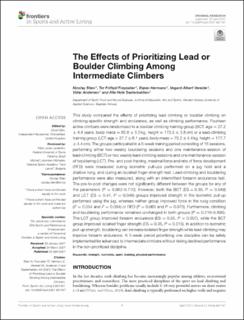| dc.contributor.author | Stien, Nicolay | |
| dc.contributor.author | Frøysaker, Tor Frithjof Hegard | |
| dc.contributor.author | Hermans, Espen | |
| dc.contributor.author | Vereide, Vegard Albert | |
| dc.contributor.author | Andersen, Vidar | |
| dc.contributor.author | Sæterbakken, Atle Hole | |
| dc.date.accessioned | 2022-02-14T13:06:30Z | |
| dc.date.available | 2022-02-14T13:06:30Z | |
| dc.date.created | 2021-12-17T09:22:39Z | |
| dc.date.issued | 2021 | |
| dc.identifier.citation | Stien, N., Frøysaker, T. F., Hermans, E., Vereide, V. A., Andersen, V., & Saeterbakken, A. H. (2021). The Effects of Prioritizing Lead or Boulder Climbing Among Intermediate Climbers. Frontiers in Sports and Active Living, 3:661167. | en_US |
| dc.identifier.issn | 2624-9367 | |
| dc.identifier.uri | https://hdl.handle.net/11250/2978826 | |
| dc.description.abstract | This study compared the effects of prioritizing lead climbing or boulder climbing on climbing-specific strength and endurance, as well as climbing performance. Fourteen active climbers were randomized to a boulder climbing training group (BCT: age = 27.2 ± 4.4 years, body mass = 65.8 ± 5.5 kg, height = 173.3 ± 3.8 cm) or a lead-climbing training group (LCT: age = 27.7 ± 6.1 years, body mass = 70.2 ± 4.4 kg, height = 177.7 ± 4.4 cm). The groups participated in a 5-week training period consisting of 15 sessions, performing either two weekly bouldering sessions and one maintenance-session of lead-climbing (BCT) or two weekly lead-climbing sessions and one maintenance-session of bouldering (LCT). Pre- and post-training, maximal force and rate of force development (RFD) were measured during isometric pull-ups performed on a jug hold and a shallow rung, and during an isolated finger-strength test. Lead-climbing and bouldering performance were also measured, along with an intermittent forearm endurance test. The pre-to-post changes were not significantly different between the groups for any of the parameters (P = 0.062–0.710). However, both the BCT (ES = 0.30, P = 0.049) and LCT (ES = 0.41, P = 0.046) groups improved strength in the isometric pull-up performed using the jug, whereas neither group improved force in the rung condition (P = 0.054 and P = 0.084) or RFD (P = 0.060 and P = 0.070). Furthermore, climbing and bouldering performance remained unchanged in both groups (P = 0.210–0.895). The LCT group improved forearm endurance (ES = 0.55, P = 0.007), while the BCT group improved isolated finger strength (ES = 0.35, P = 0.015). In addition to isometric pull-up strength, bouldering can increase isolated finger strength while lead-climbing may improve forearm endurance. A 5-week period prioritizing one discipline can be safely implemented for advanced to intermediate climbers without risking declined performance in the non-prioritized discipline. | en_US |
| dc.language.iso | eng | en_US |
| dc.publisher | Frontiers Media | en_US |
| dc.rights | Navngivelse 4.0 Internasjonal | * |
| dc.rights.uri | http://creativecommons.org/licenses/by/4.0/deed.no | * |
| dc.title | The effects of prioritizing lead or boulder climbing among intermediate climbers | en_US |
| dc.type | Peer reviewed | en_US |
| dc.type | Journal article | en_US |
| dc.description.version | publishedVersion | en_US |
| dc.rights.holder | © 2021 Stien, Frøysaker, Hermans, Vereide, Andersen and Saeterbakken. | en_US |
| dc.source.volume | 3 | en_US |
| dc.source.journal | Frontiers in Sports and Active Living | en_US |
| dc.identifier.doi | 10.3389/fspor.2021.661167 | |
| dc.identifier.cristin | 1969732 | |
| dc.source.articlenumber | 661167 | en_US |
| cristin.ispublished | true | |
| cristin.fulltext | original | |
| cristin.qualitycode | 1 | |

